Email Bounce Rate: What It Is, Types & How to Reduce (Guide)
Did you know that 65% of emails are ignored?
According to Forbes, an average inbox has over a half of disregarded messages, which can happen for many reasons.
Sometimes, the content is to blame – it simply doesn’t offer what the recipient is looking for. Spammy subject lines can also do their trick. But luckily, these things are fixable, and a few adjustments to your message can already improve open rates and CTR.
However, what should you do if your message gets returned to you?
In this guide, we’re taking a closer look at email bounce rates, what they mean, their impact on your sender reputation, and how to high bounce percentages before it’s too late.
What Is Email Bounce Rate?
Email bounce rate is the percentage of email messages that haven’t reached the recipients. In other words, they bounce back to you.
If you ever had a letter returned to you by a postman because you wrote the wrong address on the envelope, it means it bounced. However, with email campaigns, the situation is slightly more complicated.
Is there a difference between this metric and website bounce rate?
These are two different metrics. Website bounces occur when a visitor comes and immediately leaves your website or landing page. Email bounces don’t always involve the recipient doing something to your messages.
2 Types of Email Bounces
So, what can cause your messages to bounce?
To answer this question, first, we need to discuss the types of bounces, which can be hard and soft (kind of like a boiled egg).
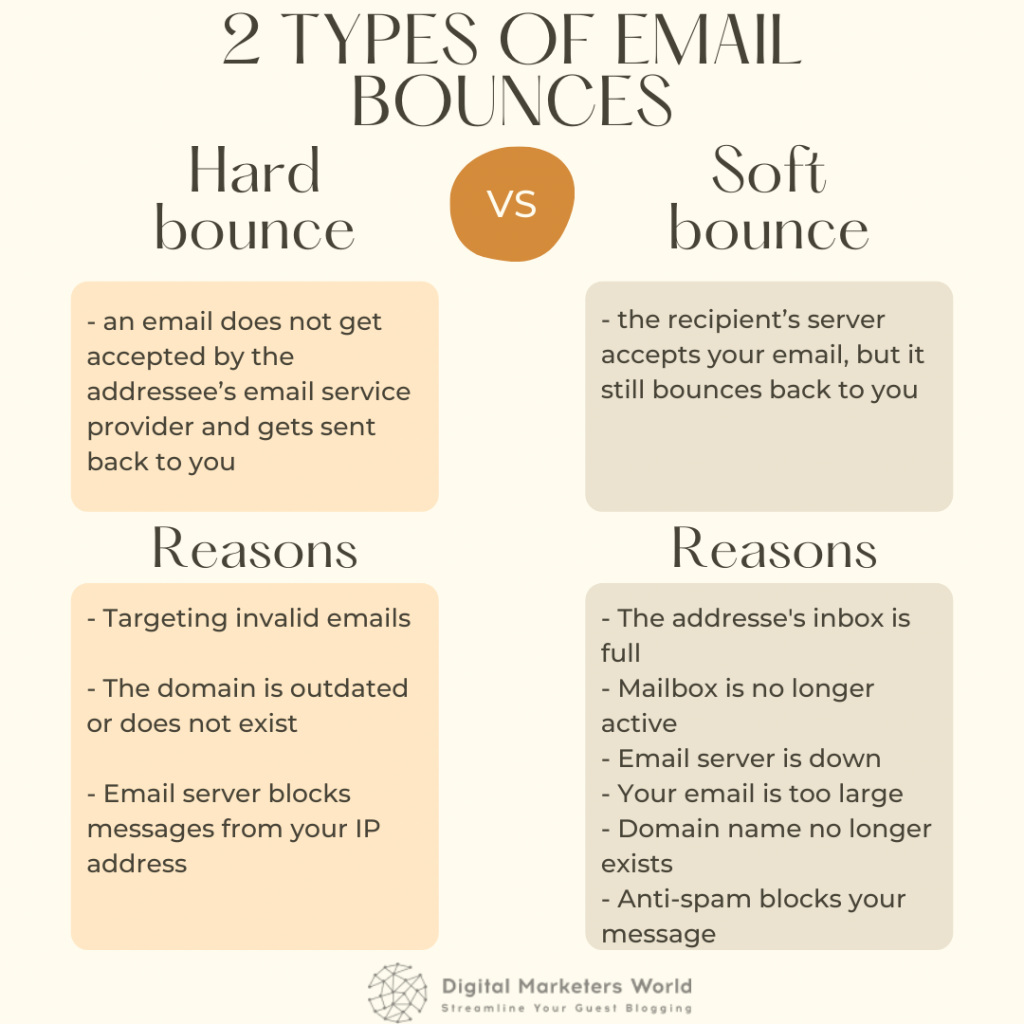
Now let’s get a closer look at each of these types.
Type #1: Hard bounce
A hard bounce occurs when your message does not get accepted by the addressee’s email service provider and gets sent back to you. It can happen for several reasons:
- You’re targeting invalid email addresses
- The domain does not exist or is outdated
- Email server blocks messages from your IP address or domain
The last point indicates that hard bounces happen due to poor sender reputation.
What can cause such a problem?
Sender reputation is tied to your actions associated with the email domain. One action isn’t likely to do anything. However, when undesired activity accumulates, you can get added to the blacklist.
The most common causes include:
- High spam complaints. Inc. has a great article with 401 words that can get your messages banned. They include well-known phrases like apply now, buy direct, click here, but also subject lines with signs $$$. Such messages get you in trouble over time and result in a permanent block.
- Low open rates. In general, this metric is very fluid and can change from industry to industry. For example, according to Campaign Monitor, educational emails have an open rate of 28.5%, while retail companies only get 17.1% of opens. These are average numbers, but if the open rate drops, it can impact your sender reputation.
- Bad prospect lists. This is one of the reasons why we told you not to buy a lead list but create one by yourself instead. The problem is if you do not check the email addresses in this list, and some of them go bad for some reason (become invalid), it can severely damage your sender reputation.
A high bounce rate can also hurt you really badly. Even a bunch of automated emails saying that you’ve contacted the wrong person or organization already have a negative impact.
Type #2: Soft bounce
Now, with a soft bounce, the recipient’s server accepts your email, but it still bounces back to you for one of the following reasons:
- The addressee’s inbox is full
- Mailbox is no longer active
- The recipient has not configured their mailbox properly
- The recipient’s email server is down
- Your message is too large
- Domain name no longer exists
- Content in your message does not comply with the mail server’s requirements
- Anti-virus blocks your letter
- Your email doesn’t fit the anti-spam requirements
So, as you can see, there are more reasons for soft bounces. However, unlike with a hard bounce, these are all temporary issues and can be fixed.
How can you do that?
There are a few ways to fix (and prevent) a soft bounce:
- Offer double opt-ins – a recipient should express willingness to remain on your email list.
- Allow opt-outs – an addressee should be able to unsubscribe at any moment (this is also required by the CAN-SPAM law.
- Be mindful of spam triggers – review the anti-spam rules of email providers to make sure your emails don’t get flagged.
- Review the content- if the information in the body of your email doesn’t correspond to what is stated in the subject line, your message will be viewed as spam.
Beware: repeated mistakes resulting in soft bounces can cause a permanent ban. So, if a soft bounce occurs once, make sure it never happens again. Watch your sender reputation like a hawk.
What’s a Good Email Bounce Rate (By Industry)?
In the previous section, we mentioned that each industry has its own average open rate. The same is with bounce rates – they vary from niche to niche.
Now, what’s a perfect percentage for the most popular industries?
Different resources show different numbers. For instance, Mailchimp gives the following hard and soft bounce rate percentages for these five industries:
- Business and finance – 0.43% and 0.55%
- Consulting – 0.50% and 0.79%
- E-commerce – 0.19% and 0.26%
- Education 0.32% and 0.51%
- Manufacturing – 0.72% and 1,18%
The average email bounce rate, according to this source, is 0.5%. This number is a bit different from what HubSpot reports, which is 0.63%. It also provides the following average percentages for the industries mentioned above:
- Finance – 0.6%
- Consulting – 0.7%
- E-commerce – 0.4%
- Education – 0.5%
- Manufacturing – 0.5%
One more resource providing these benchmarks is Constant Contact, an email automation and marketing platform. However, its averages are drastically different from what the previous two have shown:
- Finance – 10.47%
- Consulting – 10.13%
- E-commerce – 7.15%
- Education – 8.71%
- Manufacturing – 11.62%
Now, what is the reason for such polarizing results?
It’s important to understand that each of these resources collects information based on the client accounts available to them. So, take these numbers with a grain of salt, but be mindful of general industry averages – any deviation from “normal” numbers doesn’t have to necessarily worry you but should be a reason for an extra check.
Here’s some more data on different industries based on MailChimp’s research (it’s the most complete, in our opinion):
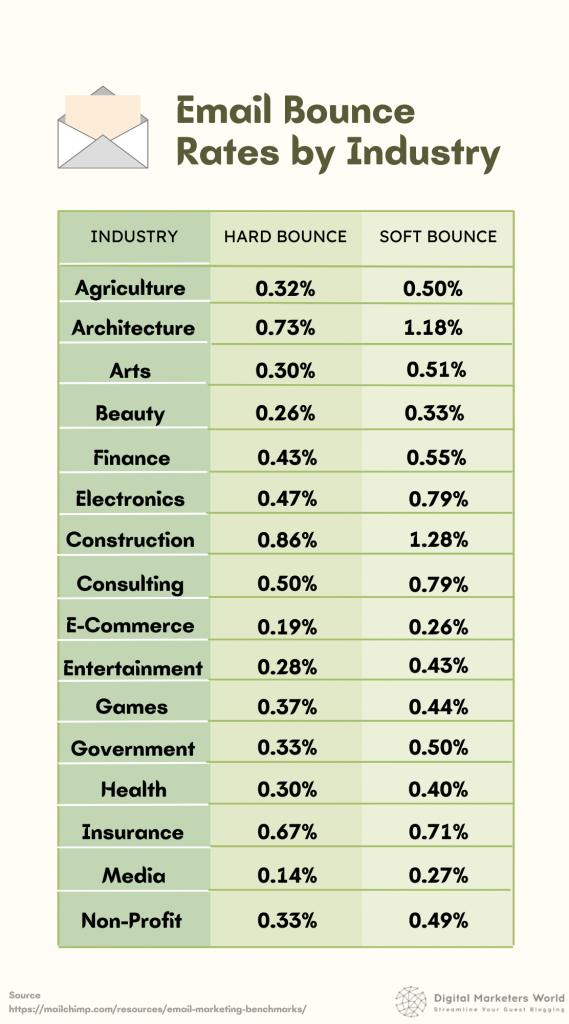
Note: the general percentage accepted by marketers is 2%. However, it’s still better to check an acceptable bounce rate for your niche.
6 Ways to Reduce Your Email Bounce Rate
Alright, now, let’s figure out how to tackle a high bounce rate. It can be done with the following tactics:
- Sticking to valid email lists
- Keeping these lists updated
- Paying attention to the content
- Allowing opt-ins and opt-outs
- Watching your subject lines
- Avoiding free sender domains
Let’s go through each of these strategies in detail, along with tips and some examples.
1. Steer clear from purchasing email lists
We already mentioned it a couple of chapters away, but it’s worth repeating once again – avoid buying email lists at all costs.
Surely, you might want (or even need) to get easy money from ready-made prospect lists, but what turns out to be quick revenue can really hurt you in the long run. Here’s why:
- Email lists become outdated. Very quickly. And we have already determined that sending a bunch of letters to invalid emails can damage your sender reputation.
- You’ll suffer from spam complaints. In many cases, people don’t realize their emails are on some list for sale, so when they start receiving messages from a company they did not subscribe to, there is a big possibility they will report your message as spam.
- Your business might get involved in a lawsuit. If you don’t check the list thoroughly before purchasing or buy it from a shady resource, you might unknowingly violate very strict rules and regulations which can even lead to jail time.
This information is not meant to scare you to death but rather to warn you about the grievances that buying an email list can bring along.
So, it’s always better to spend some time creating your own list. And, if you want quick revenue, consider investing in online ads instead – at least, this way, you’re not doing anything illegal.
2. Make sure email lists are clean and updated
Now, on to your own lists – although we encourage you to create your own, it doesn’t mean that you’ll just have to collect recipient addresses and leave them at that. On the contrary – you have to continuously work and improve them over time.
What does keeping email lists clean mean?
Essentially, you remove irrelevant data from it. So, first, you’ll have to go through each subscriber’s contact information, including:
- Full name
- Email address
- Company name (for B2B)
- Job (for B2B)
You need to make sure you’re still in touch with the right person who is responsible for making purchase decisions.
Next, you want to check if your contact list is free from fake addresses. Here are a few signs you should be aware of to be able to spot a fraud:
- The subscriber’s email comes from a public domain (Hotmail, Gmail, Yahoo). It’s not always a surefire indication that it is fake, but it’s better to give preferences to addresses with corporate names.
- The domain name is misspelled. Even corporate domains can get misused. If you notice that there’s something wrong with the subscriber’s domain name, immediately exclude it from your list – such email addresses are often used for phishing by spammers. Here’s a good example from TSP IT Services:
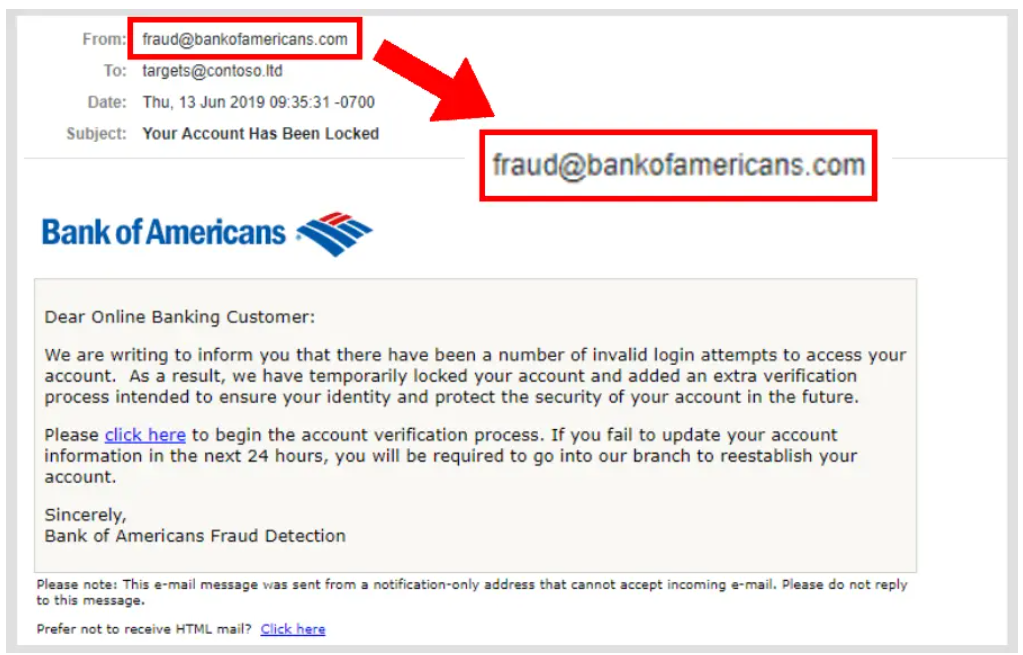
In general, any weird typos and misspellings are already a warning sign. If you spot any suspicious addresses on your subscriber list during the email verification process, we highly advise you to get rid of them as soon as possible.
Same for the inactive email addresses – they lead to higher bounce rates, and we’re trying to prevent that. Your contact list should only contain active subscribers.
How often should you do the cleanup?
At least once a quarter. However, if you see that the bounce rate remains high, keep investigating the reasons to make sure you don’t get flagged.
3. Keep your emails personal and informative
We already mentioned a bit earlier that the content in the body of your email can significantly increase the bounce rate, mainly if it’s misleading or spammy. Spam filters work pretty well nowadays, so even the slightest mistake can be the reason why your message ends up banned. In the example, the formatting became the reason this letter ended up in the Spam folder:
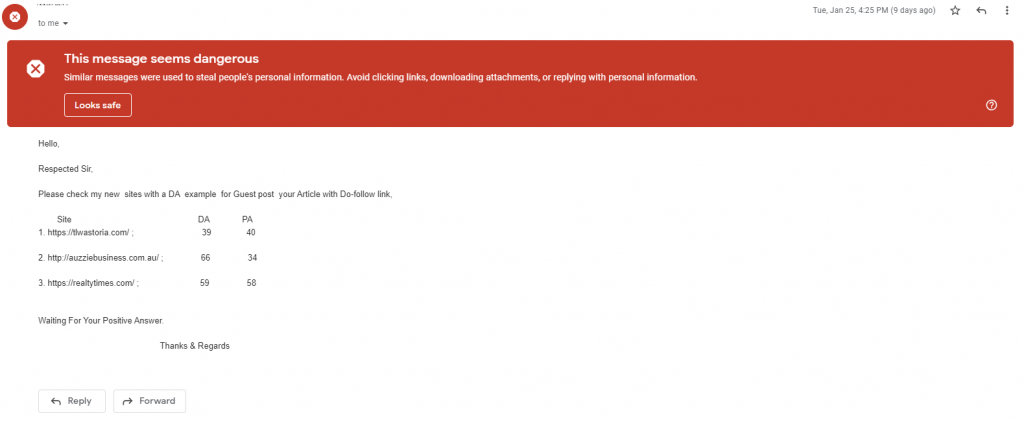
So, to keep that from happening, it’s important to create personalized emails catered to the needs of each subscriber on your list. This can be possible thanks to the following strategies:
- Segmentation. You can break down your recipients based on demographic or psychographic factors as well as their previous purchase behaviors.
- Use the addressee’s name. It’s an obvious yet often overlooked tactic to add personalization and avoid a soft bounce.
- Behavior triggers. Messages sent based on the recipient’s last action on your site also fall into the personalization category.
In general, work out ways to offer something valuable and relevant to the recipient and build email content around it. However, even this won’t save you from a ban if you overstuff your message with call-to-action buttons. The design also matters – keep it simple and uncluttered.
4. Make sure you ask for an opt-in confirmation
If you’ve got a chance to look through our article on lead lists, you know that, under the CAN-SPAM act, each email sender should provide a possibility to opt in to receive messages.
What does an opt-in letter look like?
Imagine you subscribed for an online tool. You provide your email address to start using it, but before you do, the creators of this platform send you a message to confirm the information you provided. If you do it, it means you’ve allowed them to send other stuff to your inbox.
Here’s a great example of a confirmation email from Overloop:

Essentially, if the email account does not get confirmed, you can send one follow-up as a reminder, but if you see no action, it’s your clue that the subscriber doesn’t agree to receive your messages.
There are several rules to follow when creating opt-in emails:
- Clarity – you should be as straightforward as possible about what a subscriber is getting involved in.
- Concision – don’t beat around the bush and go right to the point.
- Consistency – these are automated letters, so make sure every subscriber gets one.
Your signup form should also contain opt-in messages asking for subscriber’s confirmation that they want to receive promotions from you. Overloop, for instance, made the opt-in button very simple. Basically, if you agree to the Terms and Conditions, you also consent to receive other information from the company:
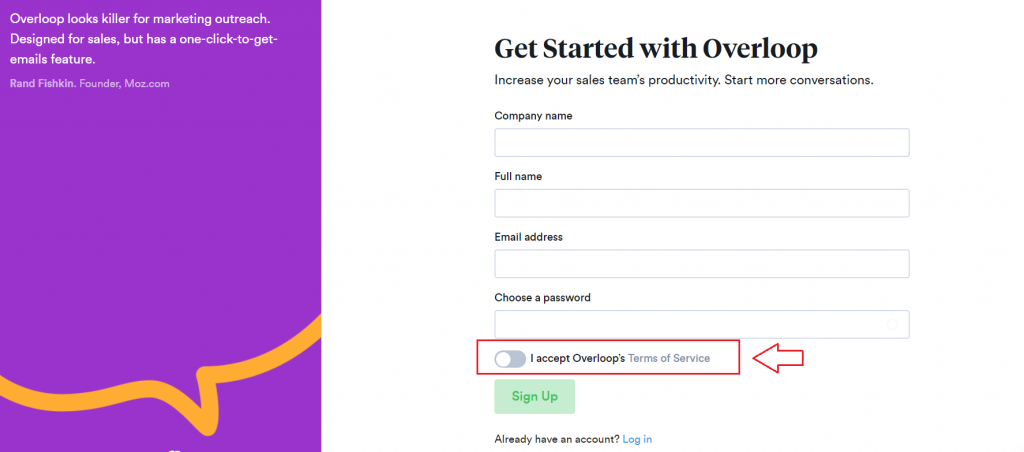
What Overloop uses is called a double opt-in. This method is more for preventing a high email bounce rate and keeping you out of trouble. So, make sure you follow this practice to preserve a positive sender reputation.
5. Watch your email subject lines
A bit earlier, we shared an Inc. article with you, where the resource lists over 400 spammy words and phrases often used in email subject lines. These words also affect bounce rates as they get spotted by the anti-spam system.
Apart from that, it also matters how you put together your subject line. Sometimes, even using an exclamation mark can be considered as a sign of spam; the same goes for a question mark, too. Here’s proof:
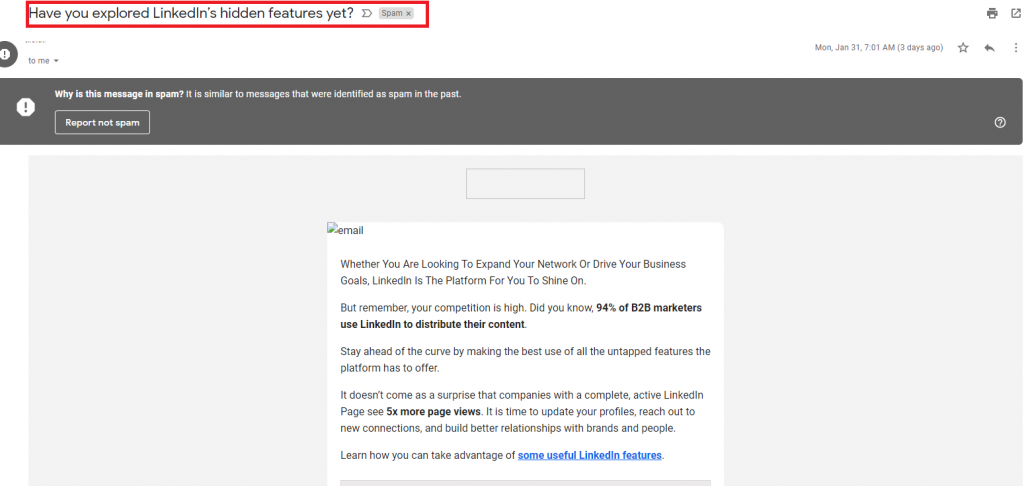
As you can see, a seemingly ordinary message gets flagged because of the question mark at the end.
So, how can you avoid that?
Doing an A/B test is the only way to ensure that your email subject line won’t be perceived as spam. Basically, you create two versions of your subject line, divide your contact list randomly, and assign one subject line to each group of recipient addresses. Next, wait two or three days to see which one gets more click-through and open rates. If none come back with results, keep testing your subject lines.
6. Avoid free sender domains
One final point worth mentioning is the domain from which you send your messages. If you want to reduce bounce rates and prevent the percentage from climbing up, you should swap your free email service for a corporate one.
Why?
Before the message gets delivered to the intended recipient’s mailbox, it should be authenticated (through Sender Policy Framework, or SPF, and the DMARC policy, an email authentication protocol). If you use a custom domain, not a free one, you can use SPF and DKIM to improve email deliverability. Otherwise, the chances of a message from a free domain getting flagged are too high, which can cause your bounce rates to jump through the roof.
Bonus: How to Calculate Your Email Bounce Rate
Okay, we’ve talked about everything related to bounce rates so far – types, industry averages, best practices, and examples. But how do you calculate them?
The formula is simple:
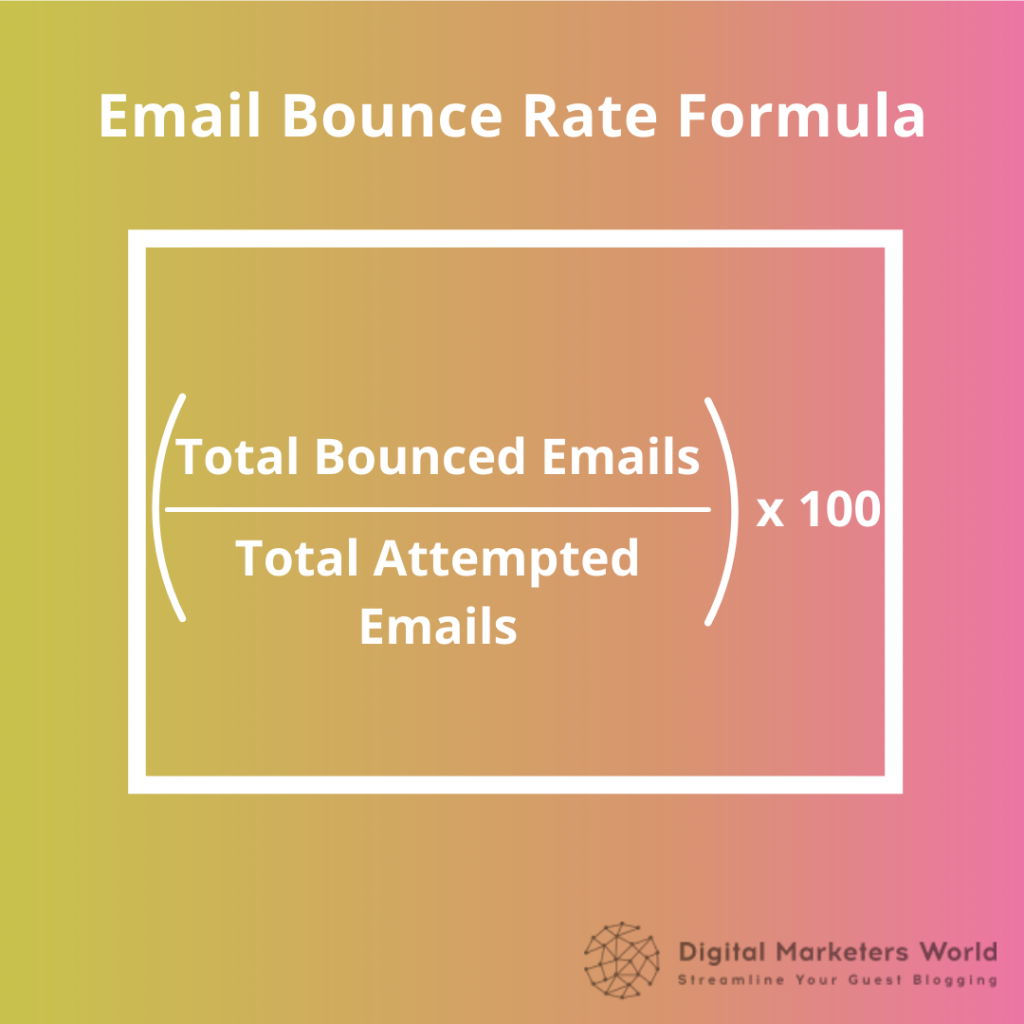
You should check this metric as often as possible, especially during an email marketing campaign. This way, you will know that nothing is threatening your sender reputation.
Over to You
As it often happens in digital marketing, most things that happen are in your control. The same is with bounce rates – keeping them at bay is an ongoing process you should commit to religiously.
Let’s go through the ways of reducing bounce percentage once again:
- Use only valid email addresses
- Update your lists regularly
- Be mindful of the content and design of your letter
- Use double opt-ins
- A/B test your subject lines
- Don’t send messages from free sender domains
These tactics also work perfectly as preventative measures, so even if email delivery rates are fine now, you can still use these tips.
Interested in more articles on similar topics? Check out our recent guide on email retargeting!
Frequently Asked Questions (FAQs)
Here are a few more important things we want to address regarding this topic.
Q1. What is an acceptable email bounce rate?
As a rule of thumb, bounce percentages that go over 2% are already considered high. However, check with your industry averages to be sure.
Q2. What are the benefits of a low bounce rate?
A low bounce percentage means your messages have high deliverability rates and engagement rates and therefore are relevant to the recipients. This is an indicator of a successful email marketing strategy.
Q3. How do I know if my email has a bounce rate?
Simply divide the number of email bounces by the total number of messages sent – it will help you understand if they are bouncing back or not.

Mariia is a content strategist and editor at Digital Marketer’s World. She is passionate about educating others on all things marketing and believes in the power of the written word.
